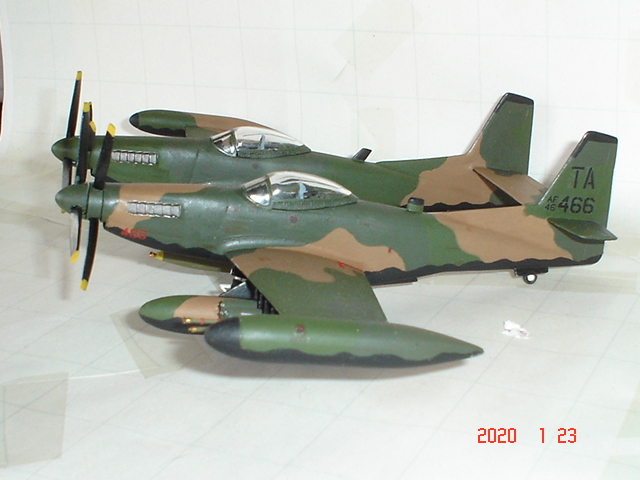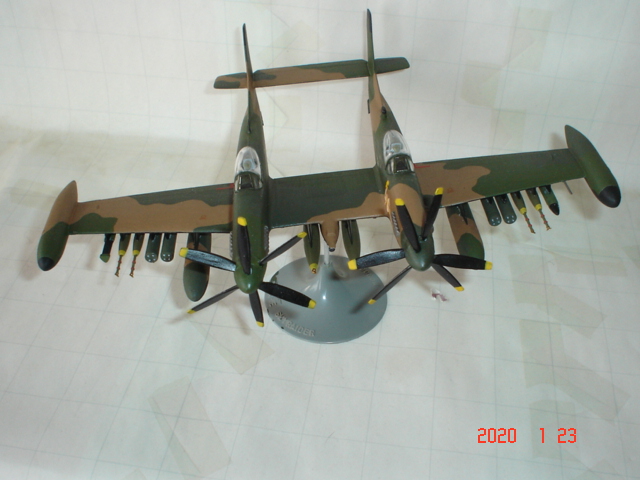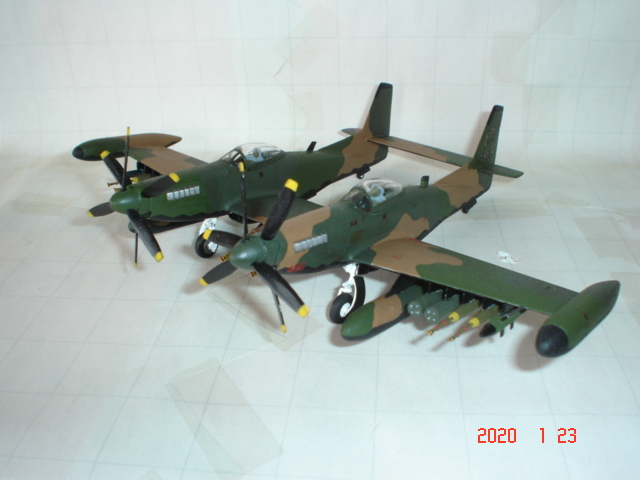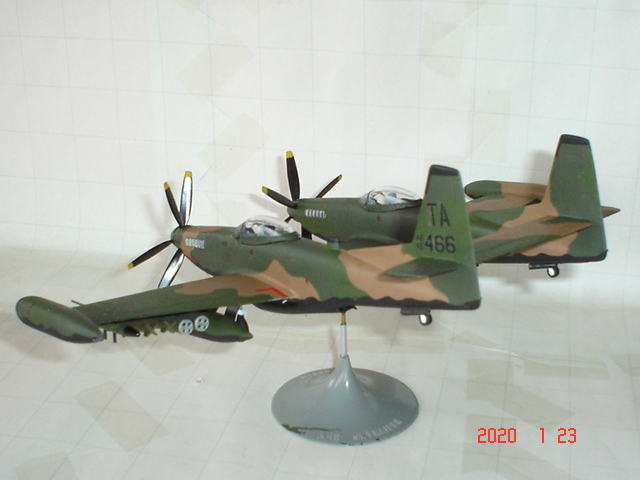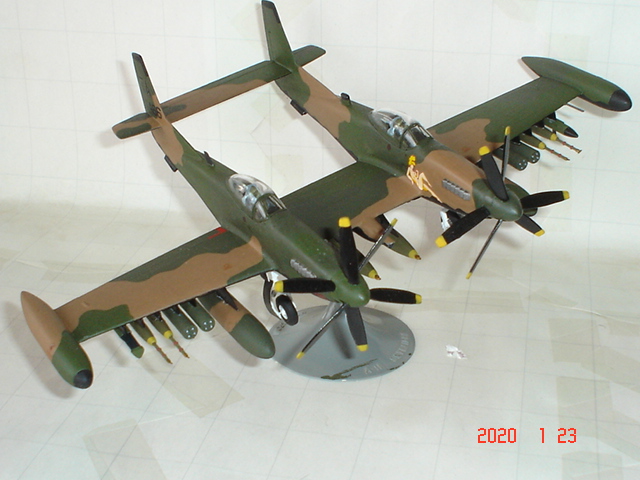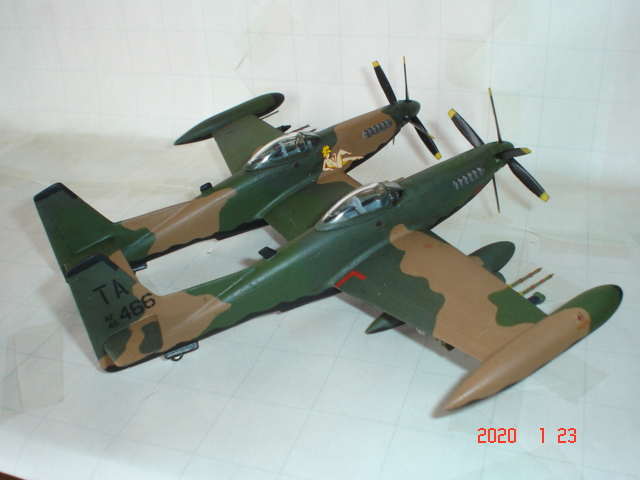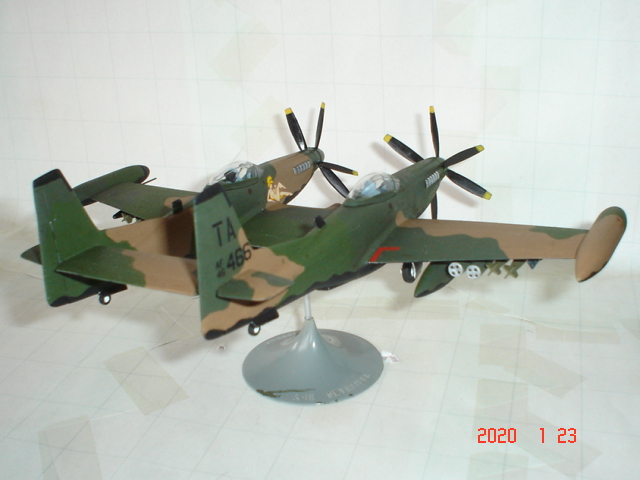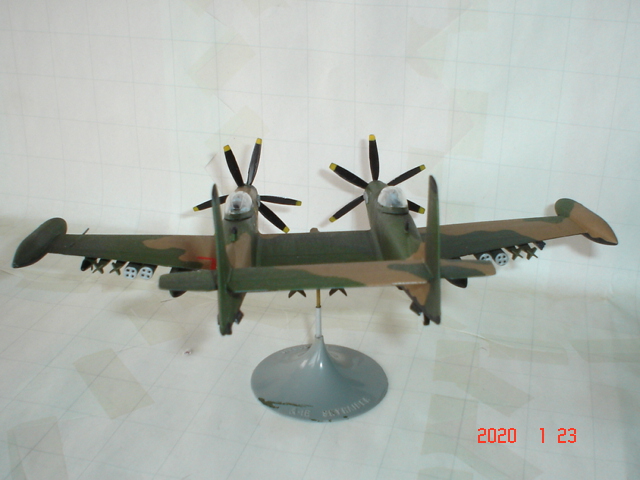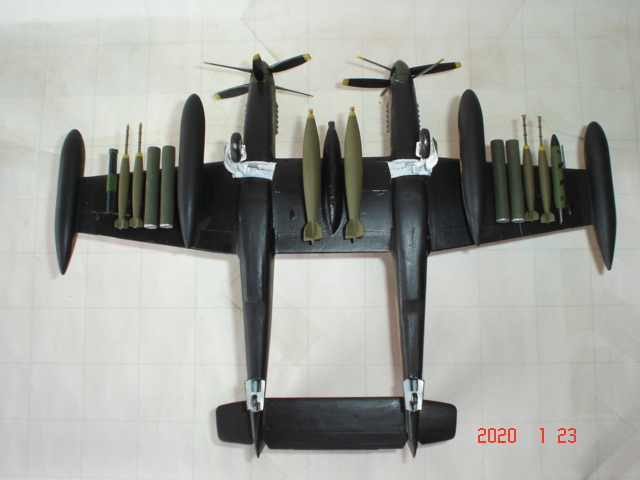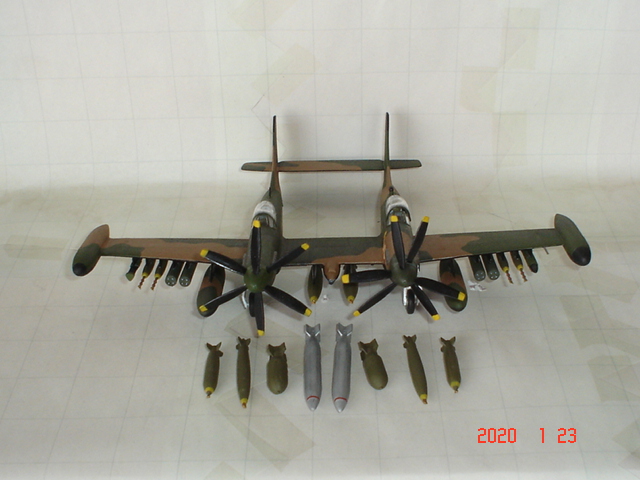This is a project I've built for a GB over on the What-If Forum which is called the 'Out of Retirement' GB. And amazingly, I managed to finish it in time

So here's the story.
So this is about the F-82's which were remanufactured for the ground attack role for use in Vietnam.
The F-82's had been retired after the Korean war and moved to storage yards or boneyards where the thought was to resell then to small countries needing a more modern air force. However they languished there as not a lot of interest was shown and then they got forgotten about.
But with USA’s involvement in Vietnam ramping up, the USAF realized they would need some aircraft to use in the Close Air Support role. They had seen that the USN were using Douglas Skyraiders very effectively so put together a list of similar aircraft they could get hold of relatively quickly because what Skyraiders there were, weren’t available to them. Scavenging the storage areas they discovered numerous old aircraft which could probably do the job, T-28 Trojans, Douglas Invaders and the NAA F-82's among them. It was decided then to re-activate as many of the aircraft that could be made airworthy.
The USAF was particularly interested in using the F-82 because of its previous history, it being designed almost from the start to have a ground attack capability, and the requirement was it had to be on par with the Skyraider or better. The biggest problem they had was finding engines, numerous airframes had had them removed, an investigation as to why revealed the majority of them were sold off to various racing disciplines who wanted big powerful V-12 engines which were then highly modified, and not suitable for re-use in their intended role. The use of the F-82's might have ended right there but it was discovered they could have a supply source for an equivalent engine from Rolls Royce. After some enquiries they found that the RR Griffon engine was still in production for the RAF, although it was for the Avro Shackletons that were soldiering on in their maritime/AEW roles. Just as fortunately, it was discovered that RR even had plans to re-engine the RAF's P-82's they were supplied with in the closing stages of WWII because of the then Air Ministry's requirement of standardizing aircraft on three engine types, the Griffon, Sabre and Centaurus. The discovery of these documents and drawing greatly helped in progressing the plan to re-activate the F-82's in their new role.
With the supply of engines secured (at first, engines were taken from the Shackleton engine pool), North American was then brought into the picture, where they sent a team of technicians to evaluate all the F-82 airframes found in the storage areas. They found that although they looked really tatty, most were in a fairly good condition, nothing that some refurbishment wouldn't go amiss.
Another USAF requirement was to standardize the fix armament with what was in service at the time, they wanted the six M3 .5’s replaced by four M39 20mm revolver cannons. NAA had experience with this cannon already, being used in their late F-86’s, most of their FJ Furys and more lately, the F-100 Super Sabre.
The switch over was a fairly easy conversion and was incorporated while the wing was re-manufactured with strengthened wing spars to support the multitude of pylons for the stores to hang from. Other parts of the airframe were strengthen, and even had some armour added around vital parts. The first F-82 to be re-flown was one which was found to be in really good condition so was used as a test bed for the Griffon installation, the contra-rotating propeller coming straight off a Shackleton. Prop tip to ground clearance was very minimal and the test pilot had to be very careful not to over rotate when taking off and landing. While these tests were ongoing, RR had arranged for two pairs of contra-props to have the blades shortened and also to revise the PSRU’s gear ratios to suit them. The new props were install as soon as NAA got them and further testing was completed successfully. The second F-82 to fly, now re-designated as an AF-82, was one that had been refurbished with the re-manufactured wing plus the additional armour installed and also had the revised engine with the smaller diameter props. This was used in testing the aircraft capabilities of carrying various ordnance and gun firing trials. With this testing completed satisfactorily, refurbishing the remaining airframes progressed rapidly.
As each aircraft was completed, and flight tested, they were flown out to Vietnam in batches directly from California, via Hawaii then Guam, then to airfields either in Vietnam or Thailand, the AF-82’s making use of the very long range capability they had. The aircraft’s wing had been modified to have wing tip tanks, but also the four heavy duty pylons it was equipped with were also plumbed for drop tanks. They were very quickly put to good use once the squadrons in the Vietnam theatre received them, and they became a very welcome sight for the ground troops. The operational success of the aircraft was partly due to the USAF still having a large community of pilots who had had previous experience with the F-82, and many of them jumped at the chance to fly the aircraft again.
It wasn’t long before the capabilities of the aircraft garnered attention from another group operating in Vietnam, some who had been there even before the US involvement intensified. This was the CIA contingent. A couple of their high commanding officers manage to cadge operational rides so they could personally access the aircraft and then made very favorable reports back to the higher command in the USA. The CIA’s equipment acquisition department was instructed to approach NAA management to enquire about the possible purchase of the AF-82 for themselves and a series of meetings followed rapidly. Very early in these meetings, NAA informed the CIA there was the question of available airframes, in that the USAF had commandeered most of them and that what was left were airframes the USAF didn’t want to spend money on, these needing a lot more work on them to get them airworthy.
But money didn’t seem to be the issue for the CIA, what they wanted was aircraft for themselves. Which led to the remaining airframes getting refurbished. However, because of the nature of their operations where their targets had to be more precisely attacked, the CIA specified certain equipment installed, including AN/APG-53A Air to Air/Air to Ground targeting radar with its associated ground avoidance and weather radars, a AN/ARN-6 Radio Compass plus a special CIA radio for their operative who was to fly on all missions (apart from the pilot). They also required an ELQ-87 ECM pod and a SUU-14a dispenser. All the pylons be rated for heavier ordnance than what the AF-82 pylons were capable of, and also able to carry anything in the US Forces inventory was another requirement. The CIA then informed NAA that from now on, their AF-82’s would be designated A-11.
So NAA then set about modifying one of the remaining F-82 airframes to meet the new standard. With the AN/APG-53A radar and its associated radars installed in the front ends of the wing tip tanks and all the other extra equipment and expected heavier carriage of ordnance came at a performance price though, and to maintain that performance NAA figured a more powerful engine would be needed. NAA once again approached RR to see what was available to which RR said they could bump up the power of the Griffon 57’s fairly easily, to the tune of 3 to 4 hundred more hp. RR said though, they wouldn’t recommend using the smaller diameter propeller, that if NAA could use the original 12’-6” diameter one it would be better, but then said no smaller than 12’-0” diameter. This created a couple of problems, not just prop clearance for the line of fire of the four cannon but with the same prop tip to ground clearance found earlier too. NAA’s solution for the cannon was to reduce the number to two, but during a meeting, the CIA said they still wanted the hitting power of the four cannon and it was explained that only two would have the line of fire clearance with the prop blade tips. A few days later the CIA came back with a suggestion, if installing the M61 rotary cannon would work, they would use that and send one over for a trial installation asap.
The NAA designers thought this would be the right direction to go in, and once an example arrived, found that it couldn’t be mounted in the wing like the four M39’s. It was decided to mount the gun directly under the wing with the main mounting bracket attaching to the bottom of the front wing spar plus some additional bracketry to support the mid-barrel bearing and the feed mechanism behind the breach block. The mounting and gun then had a purpose built structural fairing built around it. This arrangement then allowed for more ammunition to be stored inside the wing where the former cannon were positioned.
While this was going on, other designers were working on the prop tip to ground problem, which was obviously down to making the u/c leg longer. But the position of the M61 mounted under the wing in the center, nullified any extension to the wheel bay in that direction. In the end, the solution was fairly simple, they borrowed an idea that Grumman had used on their F8F Bearcat, this involved the upper u/c leg folding itself in half and all that was needed to be done was to extend the u/c bay where the leg itself retracted into, out a short way into the front of the outer wing. The u/c leg then had to be revise to have a robust casting attached to the top of the leg, which was then attached to a link casting which has hinge pins top and bottom, the leg being attached to the bottom hinge pin. The top hinge pin was then attached to the airframe in almost the same position as the original u/c hinge point, but a bit higher to allow for the folding mechanism to retract into the extended wheel bay. The rest of the u/c leg and wheel then retracted into the unchanged wheel bay.
With the problems now solved, production quickly got underway and within a few months, the aircraft were ready for delivery, having passed all the trials and testing relatively without any further problems. Once the CIA got hold of them though, not much is known of what happened during the war, the aircraft were seen landing and taking off from various airfields in Vietnam and Thailand, usually disappearing into a fenced off compound/hanger and what they did was cloaked in a bit of a mystery. They were present for most of the war and even after the US withdrawal from Vietnam, they carried on in the area with another service. That’s because all of the remaining AF-82’s and A-11’s were “gifted” to the Royal Thai Air Force as a reward for the use of their airfields. But that's another story for another time -----
